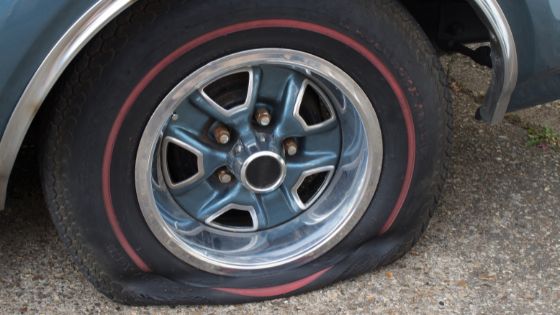People often mistake a deflated tyre for a flat tyre. But there’s a difference between the two. A flat tyre results when a car runs over broken glass or nail. It is irreparable, and you need to replace it with a new one. However, a deflated tyre refers to one that’s just low on air. All you need to do is inflate it. Read on to learn more differences between a flat tyre and vs. deflated tyre.
A flat or a deflated tyre can be scary and ruin your driving experience. Nevertheless, certain accessories for car can help you overcome these issues.

Flat Tyre Vs. Deflated Tyre: How does it happen?
Flat and deflated tyres are often due to defect, puncture, improper air pressure, or overuse. Built-in defects are rare and are visible as bulges or bumps on the tyre’s sidewalls. When you come across these malfunctions, it is advisable to have an expert inspect them right away. You can easily use a tyre inflator to save you from a deflated tyre.
Causes Of Flat Tyre
Here are some reasons that can lead to a flat tyre:
1. Sharp objects
Sharp objects are one of the most common and obvious causes of flat tyres. Things like glass pieces, screws, nails, industrial staples, sharp debris, etc., are primarily responsible for causing a flat tyre. You should drive around these objects on the road whenever you can. This is one such measure you can take to prevent your tyre from getting flat.
When driving through your parking lot, watch for debris and garbage like nails or glass on the ground. Ensure to drive the car carefully near poorly-maintained roads or construction zones.
2. Poor road conditions
No driver likes the idea of driving through uneven roads, potholes, or unexpected debris on the road. These obstacles on the road are annoying and can lead to a flat tyre. It can wreak havoc on your automobile’s undercarriage and axles. To put it simply, poor road conditions are primarily responsible for affecting a car’s tires.
Safe driving is the best way to prevent damaging the tyres in bad road conditions. If you must drive on the road, not in the best condition, be careful to reduce your speed and provide more space between your vehicle and the vehicle in front of you. This will give you more time to respond to check for potholes, road bumps, and debris and safely navigate your car around them.
3. Wear and Tear
There isn’t usually just one specific, important cause for a tyre to flat. The tyres frequently experience typical wear and tear, which is enough to render them useless. Your tyres’ tread will ultimately wear down from regular use. It’ll make them more vulnerable to road dangers, raising the likelihood that they may go flat.
Your tyres deteriorating over time is very natural. You can do a few things, though, to help reduce it. Steer clear of sudden starts and stops; align the wheels regularly; maintain tyre pressures etc. All these things will help extend the life of your tyres and keep them from going flat.
Causes Of Deflated Tyre
Keep reading to find out the common causes of a deflated tyre:
Delamination
Tyre delamination separates into various parts. It occurs due to heat, wear, improper inflation, etc. Ultimately, this separation leads to a point where the air starts to escape causing deflation. Tyre delamination often leads to blowouts. It can occur while you are on the motorway. Delamination can be dangerous for you and other cars or bikes near you.
Overinflation
Although it seems odd, overinflating your tyres might cause them to deflate. Overinflating your tyres might cause a blowout by raising their pressure to dangerous levels. It’s also important to remember that having overinflated tyres might result in you losing control of your vehicle. It is yet another incredibly dangerous scenario.
Hot weather, and heat due to road friction, can cause the tyre to expand. It results in overinflation and, in catastrophic situations, blowouts.
Underinflation
Inadequately inflated tyres are another problem. Unseated tyres from the wheel rim can cause leakage. However, in the hands of a specialist, getting your tyres re- seated shouldn’t be too difficult.
Another issue with underinflated tyres is that too much of the tread may come into touch with the ground. This might decrease your fuel efficiency and make steering incredibly difficult.
Can You Repair a Flat and Deflated Tyre?
A burst tyre is irreparable, but you can inflate a deflated tyre using an air compressor. Moreover, it still depends on the size of the puncture or its condition. A puncture less than 6mm in size at the centre of the tyre’s tread is repairable. But if it is larger than 6mm and present at the sidewall, you have to replace it.
So, this was all about a flat tyre vs. deflated tyre. If you want to purchase new tyres or air compressors, CarOrbis is your one-stop destination. They have affordable products from the best brands on their online store.

















